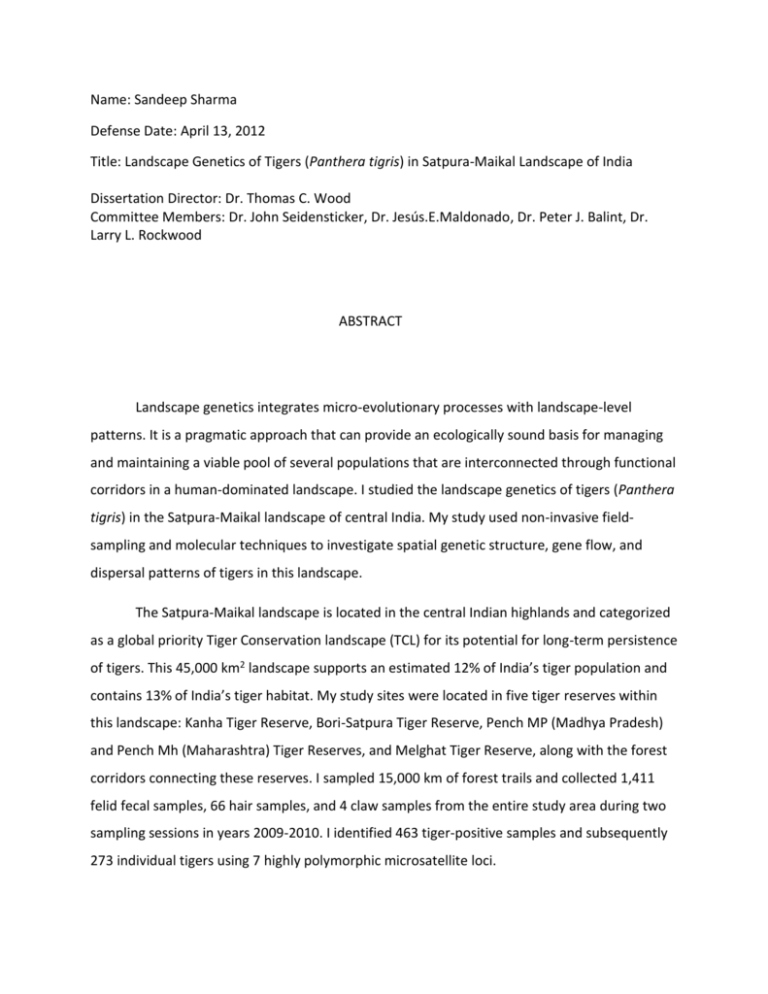Landscape Genetics of Tigers (Panthera tigris) in Satpura
advertisement

Name: Sandeep Sharma Defense Date: April 13, 2012 Title: Landscape Genetics of Tigers (Panthera tigris) in Satpura-Maikal Landscape of India Dissertation Director: Dr. Thomas C. Wood Committee Members: Dr. John Seidensticker, Dr. Jesús.E.Maldonado, Dr. Peter J. Balint, Dr. Larry L. Rockwood ABSTRACT Landscape genetics integrates micro-evolutionary processes with landscape-level patterns. It is a pragmatic approach that can provide an ecologically sound basis for managing and maintaining a viable pool of several populations that are interconnected through functional corridors in a human-dominated landscape. I studied the landscape genetics of tigers (Panthera tigris) in the Satpura-Maikal landscape of central India. My study used non-invasive fieldsampling and molecular techniques to investigate spatial genetic structure, gene flow, and dispersal patterns of tigers in this landscape. The Satpura-Maikal landscape is located in the central Indian highlands and categorized as a global priority Tiger Conservation landscape (TCL) for its potential for long-term persistence of tigers. This 45,000 km2 landscape supports an estimated 12% of India’s tiger population and contains 13% of India’s tiger habitat. My study sites were located in five tiger reserves within this landscape: Kanha Tiger Reserve, Bori-Satpura Tiger Reserve, Pench MP (Madhya Pradesh) and Pench Mh (Maharashtra) Tiger Reserves, and Melghat Tiger Reserve, along with the forest corridors connecting these reserves. I sampled 15,000 km of forest trails and collected 1,411 felid fecal samples, 66 hair samples, and 4 claw samples from the entire study area during two sampling sessions in years 2009-2010. I identified 463 tiger-positive samples and subsequently 273 individual tigers using 7 highly polymorphic microsatellite loci. I used the multiallelic genotypic information from these individually identified tigers to answer questions about spatial genetic structure and gene flow in the tiger meta-population of the Satpura-Maikal landscape. I used population- and individual-based genetic clustering methods and determined that this tiger meta-population has high genetic variation, very low genetic subdivision, and no signature of a population bottleneck. Individual-based Bayesian clustering algorithms reveal two highly admixed genetic populations. I used Bayesian and coalescent-based analyses to estimate contemporary and historical gene flow among tiger populations and to infer their evolutionary history. I found that the tiger meta-population in central India has high rates of historical and contemporary gene flow. The tests for population history reveal that tigers populated central India about 10,000 years ago. Their population sub-division began about 1000 years ago and accelerated about 200 years ago due to habitat fragmentation, leading to four spatially separated populations. These four populations have been in immigration-drift equilibrium maintained by high gene flow. I also found the highest rates of contemporary gene flow in populations that are connected by forest corridors. I used assignment tests and spatial-autocorrelation analysis to explore the dispersal pattern of tigers. I found that tigers have a sex-biased dispersal system, in which females are more philopatric than males and males disperse longer distances than females. I also found that competition is a major driver of dispersal of tigers and that their dispersal behavior is density dependent. Dispersal within a population is negatively density dependent, while long-distance dispersal is positively density dependent. Dispersal in females is more influenced by density than that in males. Anthropogenic factors such as deforestation, road widening, and mining are transforming the Satpura-Maikal landscape at an unprecedented rate. My study highlights the need to maintain the demographic and genetic dynamics of tigers. It also provides crucial information about the role of forest corridors in maintaining demographic and genetic viability of tiger populations, and suggests means to ensure the long-term viability of tigers in central India.










